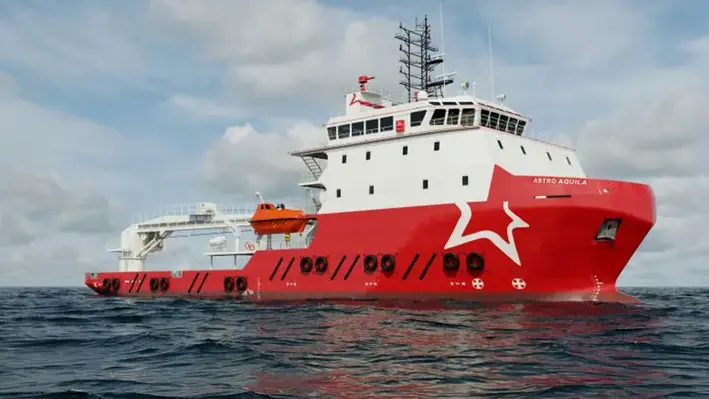
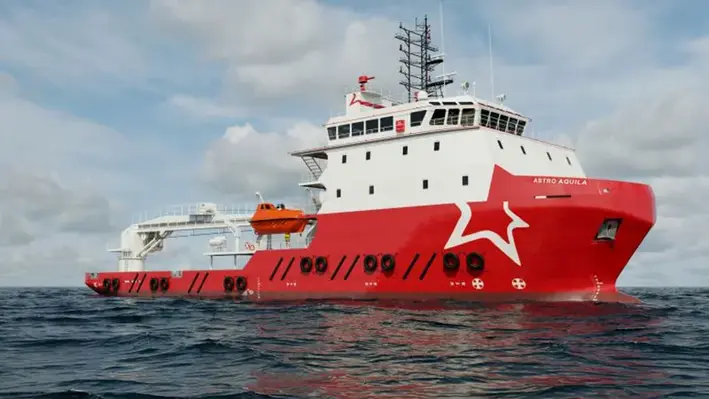 Dubai-based offshore vessel operator Astro Offshore, part of the Adani Group, has reached a major milestone by adding its 50th vessel to the fleet.
Dubai-based offshore vessel operator Astro Offshore, part of the Adani Group, has reached a major milestone by adding its 50th vessel to the fleet.
The company has welcomed the Astro Achernar, an advanced 88-metre DP2 diesel-electric multipurpose support vessel (MPSV), designed to enhance its offshore support and subsea operations.
The newly acquired Astro Achernar comes equipped with accommodation for 222 personnel and a 100-tonne active heave-compensated (AHC) crane, boosting the firm’s capabilities across complex offshore projects.
“This milestone represents more than just a number, it’s a reflection of the trust our clients place in us and the dedication of our team across every level of the organisation,” said Mark Humphreys, CEO of Astro Offshore. “With the addition of Astro Achernar, we continue to strengthen our fleet, expand our capabilities, and position Astro as a trusted partner in delivering safe, efficient, and versatile offshore support.”
The expansion reflects a period of exceptional growth for Astro Offshore, which has doubled its fleet from 25 to 50 vessels in just 12 months. Over the past six weeks alone, the company has added seven new vessels, with the Astro Achernar marking the eighth in this rapid phase of development.
This strategic growth highlights Astro Offshore’s commitment to delivering high-performance solutions and maintaining its reputation as one of the region’s most reliable offshore support providers. With a focus on safety, innovation, and operational excellence, the company continues to strengthen its position in the global offshore market.
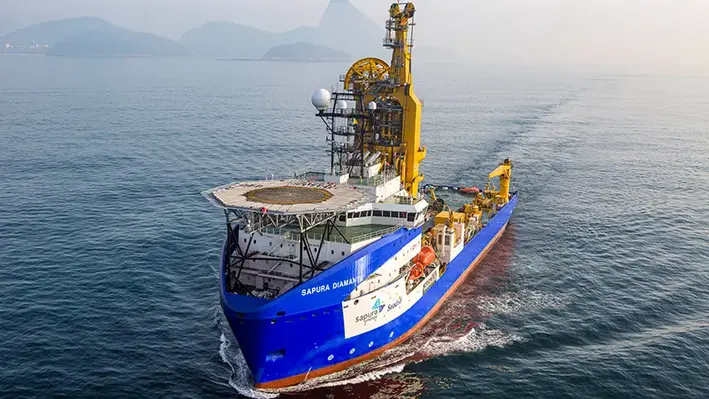
 Malaysian offshore services provider Vantris Energy, formerly known as Sapura Energy, has signed a significant long-term agreement with Saudi Aramco to support its offshore operations.
Malaysian offshore services provider Vantris Energy, formerly known as Sapura Energy, has signed a significant long-term agreement with Saudi Aramco to support its offshore operations.
According to a recent Bursa Malaysia filing, the agreement covers the provision of diving support vessels, remotely operated vehicles (ROVs), and the deployment of highly skilled diving and technical personnel. These resources will assist Aramco in a range of offshore activities, ensuring safe and efficient operations.
The contract is set to commence on 1 May 2027 and will continue until 30 April 2034. It includes services such as inspection, survey, photography, non-destructive testing, structural maintenance, and repair work. While financial terms were not disclosed, the deal is expected to make a positive contribution to Vantris Energy’s earnings and further strengthen its order book.
“This achievement validates our strategic direction to strengthen our operations and maintenance portfolio while expanding beyond Malaysian waters,” said Muhammad Zamri Jusoh CEO of Vantris Energy.
This agreement marks another step in Vantris Energy’s strategy to grow its presence in the global offshore services market.


Fugro announced that it would showcase its latest digital innovations in offshore asset management at ADIPEC 2025, taking place in Abu Dhabi from 3–6 November.
Visitors to Fugro’s booth would see how the company was transforming conventional inspection workflows through advanced digital solutions, uncrewed surface vessels (USVs) and AI-powered analytics — all aimed at helping clients make faster decisions, lower costs and enhance sustainability.
Presented under the theme “Digital Geo-data”, Fugro’s exhibit would demonstrate how cutting-edge technology was redefining the monitoring and maintenance of offshore infrastructure. Among the key technologies were high-resolution 3D point clouds that replaced static drawings with interactive, navigable visuals; digital twins offering continuously updated virtual replicas of offshore assets for improved planning and maintenance; and AI-driven systems that automatically detected corrosion, flooded members and structural anomalies to enable predictive maintenance.
Fugro’s integrated approach focused on continuous, intelligent inspection using USVs to perform regular remote surveys. The data collected from these missions fed into AI platforms that identified potential issues before they developed into critical problems. This proactive system helped clients avoid costly downtime, strengthen asset reliability and make informed operational decisions.
The benefits of this digital transformation were clear: improved efficiency, reduced operational expenses and comprehensive datasets to support long-term asset management strategies. Fugro’s remote and autonomous technologies also contributed to sustainability objectives by reducing offshore vessel time and lowering CO₂ emissions, reinforcing the company’s commitment to a safer, more efficient and environmentally responsible offshore industry.
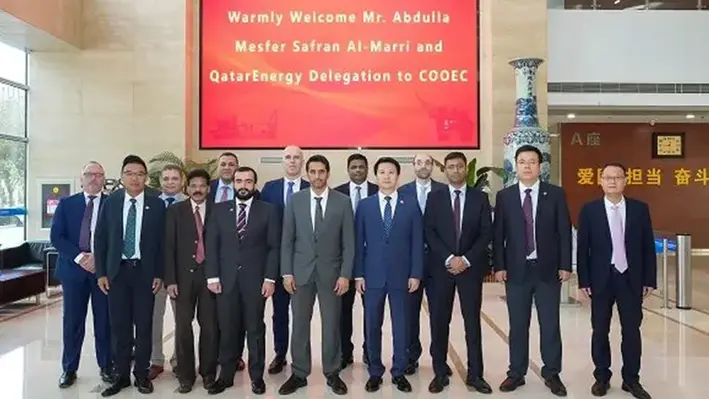
 The Qatar BH EPIC EPC (Engineering, Procurement and Construction) project is set to take off as Offshore Oil Engineering Co., Ltd. (COOEC) has kick-started meetings for the project development in Tianjin and Singapore.
The Qatar BH EPIC EPC (Engineering, Procurement and Construction) project is set to take off as Offshore Oil Engineering Co., Ltd. (COOEC) has kick-started meetings for the project development in Tianjin and Singapore.
This marks the full-scale launch of the largest international offshore oil and gas EPC project contracted by a Chinese company to date. Playing an important role in developing high-quality international oil and gas collaboration under the Belt and Road Initiative, the project will take China-Qatar energy cooperation to new heights.
Situated in the Bul Hanine (BH) oilfield in the Qatari waters of the Persian Gulf, about 100 kms east of the country's coastline, the project will be developed by QatarEnergy with substantial investments. It has a maximum water depth of approximately 40 meters.
Beyond its record-breaking contract value, the project also stands out for its unprecedented scope and technical complexity. It includes more than 60 offshore oil-and-gas facilities, as well as 40 subsea pipelines and cables, and covers the modification of existing platforms and the decommissioning of obsolete facilities.
The full-scale launch of the BH EPIC project will deepen energy cooperation between China and Qatar, and play an important role in advancing energy partnerships among The Belt and Road countries.
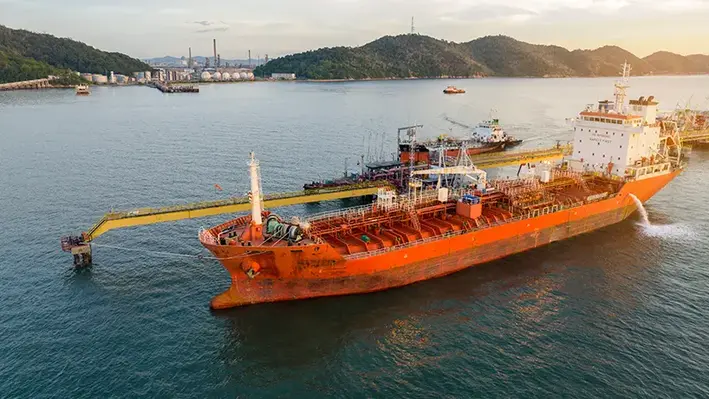
 Kuwait Oil Company (KOC), part of Kuwait Petroleum Corporation (KPC), announced the discovery of the Jaza Offshore Gas Field on Monday, which has achieved the highest vertical well output ever recorded from the Minagish formation in Kuwait
Kuwait Oil Company (KOC), part of Kuwait Petroleum Corporation (KPC), announced the discovery of the Jaza Offshore Gas Field on Monday, which has achieved the highest vertical well output ever recorded from the Minagish formation in Kuwait
This marks a significant milestone following a series of successful maritime exploration ventures, including the discovery of the Al Nokhatha field in July 2024 and the Al Jlaiaa field in January 2025, according to KPC's statement.
Initial tests on the Jaza-1 well have shown impressive production levels, with natural gas output exceeding 29 million standard cubic feet per day (MMSCFD) and condensates exceeding 5,000 barrels per day (BPD). The reservoir stands out due to its low carbon dioxide content, the complete absence of hydrogen sulfide, and the lack of associated water, making it a rare and environmentally significant find in the region.
The initial assessed area of the field spans about 40 square kilometres, with early estimates placing its reserves at around 1 trillion standard cubic feet of gas and over 120 million barrels of condensate. This equates to approximately 350 million barrels of oil equivalent (BOE). KOC noted that these early figures are subject to revision, with further exploration across the field's prospects likely to increase the overall reserves.
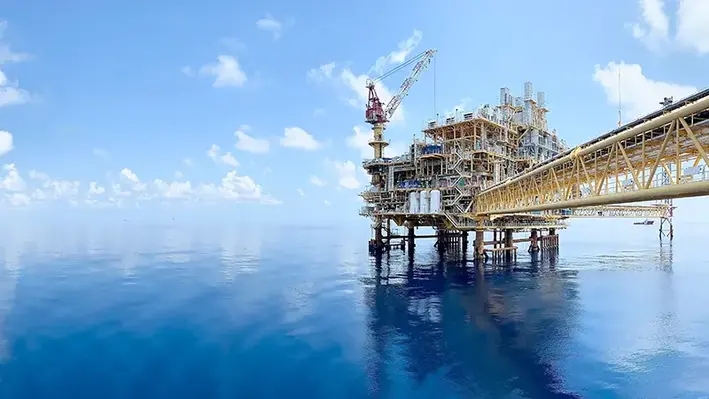
 QatarEnergy, the state-owned energy giant of Qatar, has taken a significant step to expand its oil and gas exploration portfolio by securing a stake in an offshore block in Egypt.
QatarEnergy, the state-owned energy giant of Qatar, has taken a significant step to expand its oil and gas exploration portfolio by securing a stake in an offshore block in Egypt.
The company has entered into a deal with Shell, subject to approval by the Egyptian government, granting QatarEnergy a 27% participating interest in the North Cleopatra exploration block. Shell will continue to operate the block with a 36% share, while Chevron holds 27% and Tharwa Petroleum Company has 10%.
The North Cleopatra block is situated in Egypt’s frontier Herodotus basin, covering more than 3,400 square kilometres and reaching water depths of up to 2,600 meters. Positioned north of the North El-Dabaa block, where QatarEnergy already holds a 23% stake, this new venture further strengthens the company's exploration activities in the region.
Saad Sherida Al-Kaabi, Qatar’s Minister of State for Energy Affairs and President of QatarEnergy, expressed his satisfaction with the deal, noting that the acquisition expands QatarEnergy’s presence in Egypt’s upstream sector. He also thanked the Egyptian Ministry of Petroleum and the company's partners for their ongoing support and cooperation.
This move comes soon after QatarEnergy, in partnership with TotalEnergies and SNPC, won an offshore exploration permit in Congo, further boosting its international growth ambitions.
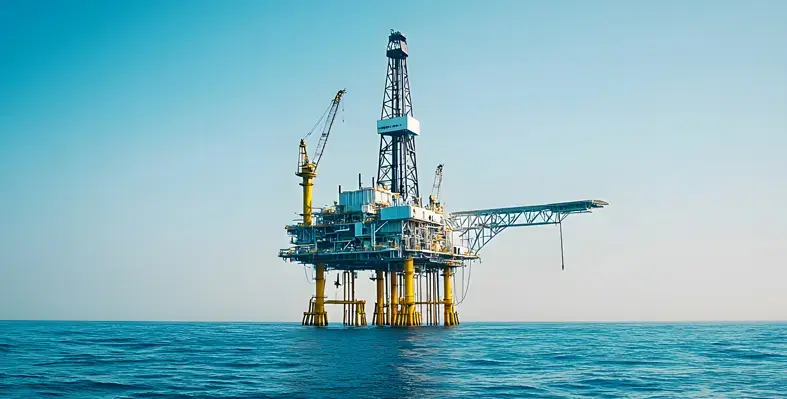

Perenco North Sinai Petroleum, a subsidiary of Egypt Kuwait Holding (EKH), has signed a new agreement with Egypt’s Ministry of Petroleum and Mineral Resources (MoMPR) to extend its tenure over the North Sinai Offshore concession until 2035, according to various news reports.
Under the 10-year reassignment, the company is committed to drilling three new exploratory oil and gas wells in the concession area.
The agreement was finalised during Petroleum Minister Karim Badawi’s September visit to Perenco’s facilities in North Sinai. The extension aims to unlock further exploration potential and expand reserves, aligning with Egypt’s national strategy to raise hydrocarbon output and safeguard future energy supplies.
Badawi noted that the deal reflects the growing trust of international investors in Egypt’s energy sector. He highlighted the ministry’s competitive licensing rounds as a key driver of new exploration partnerships, which in turn support higher production levels and meet local market needs.
Jon Rokk, CEO of EKH, described the extension as evidence of the company’s long-term commitment to Egypt.
“This agreement is a clear demonstration of the company’s role as a trusted partner in advancing Egypt’s energy future. By leveraging our strong track record and global partnerships, we are creating new exploration opportunities, transferring know-how, and generating high-value jobs for Egyptian youth.”
The reassignment was signed by Raafat El-Beltagy, CEO and representative of Perenco companies, and Salah Abdel Kerim, CEO of the Egyptian General Petroleum Corporation (EGPC), in the presence of Minister Badawi and EKH’s leadership.
Perenco North Sinai Petroleum, previously known as Offshore North Sinai, has operated the concession since 2014. The company currently runs six wells across a 443 sq km block in the Mediterranean, holding additional reserves of 223 bcf as of 31 December 2024, and averaging daily production of 53 mmscf/d last year.
Founded in 1997 and listed on both the Egyptian and Kuwaiti stock exchanges, EKH has expanded over the past two decades into one of the region’s fastest-growing investment firms, with a diverse portfolio across the Middle East and North Africa.


The UAE’s offshore sector is poised for a major expansion, with nearly 83,000 skilled positions expected to be created within the next five years, according to new analysis from recruitment specialist Robert Walters.
The report forecasts that the industry could inject as much as US$7bn (Dh25.7bn) into the national economy by 2030, compared to its current contribution of US$4.79bn. This represents growth of around 46 per cent, underscoring the offshore industry’s increasing role in the country’s economic diversification.
Traditionally linked to oil exploration and drilling, offshore activity now encompasses a wider range of operations carried out beyond coastal waters, from energy extraction to advanced infrastructure development. For decades, global and local companies have maintained a strong presence in the UAE, employing thousands across these activities.
Phill Brown, head of market intelligence at Robert Walters, said the findings reflect how offshoring is shifting from a cost-saving measure to a strategic driver of growth.
Several factors underpin this momentum: the UAE’s strategic position linking Europe, Asia, and Africa; its business-friendly environment; a digitally advanced infrastructure; and strong government support for innovation and new technologies.
As a result, more international firms are relocating complex offshore functions to the Emirates. Demand is rising for professionals in areas such as cybersecurity, artificial intelligence, machine learning, and product analysis, signalling a shift toward knowledge-based roles rather than traditional manual offshore work.
By positioning itself as a hub for offshore talent and innovation, the UAE is expected to capture a growing share of this evolving sector, further cementing its role as a global business and energy leader.

 Astro Offshore, part of the Adani Group, has taken another significant step in expanding its offshore fleet with the en bloc acquisition of five additional DP2 vessels.
Astro Offshore, part of the Adani Group, has taken another significant step in expanding its offshore fleet with the en bloc acquisition of five additional DP2 vessels.
This move increases the company’s total fleet size to 49, including 15 DP2 units, five of which feature diesel-electric technology.
The newly acquired vessels include four platform supply vessels (PSVs), two powered by diesel-electric systems, and one advanced 86-metre multipurpose supply vessel fitted with a 160-tonne crane. This purchase builds on the company’s recent addition of two modern PSVs and further strengthens Astro’s ability to deliver flexible, future-ready solutions across key offshore regions.
Industry observers see the acquisition as a strategic effort to expand Astro’s reach in West Africa while enhancing its operational capacity and geographical flexibility. By investing in diesel-electric vessels, the company underlines its commitment to smarter, cleaner, and more efficient offshore operations. Three of these advanced vessels form part of the latest deal, while two more sister vessels, Sagitta and Sculptor, are expected to join the fleet in the coming weeks.
Mark Humphreys, CEO of Astro Offshore, said,“This latest acquisition further enhances our global presence in the offshore sector and reaffirms our commitment to meeting both the current and future needs of our valued clients. The en-bloc transaction underscores our ambition to operate one of the world’s youngest and most efficient fleets. We are excited to bring this new tonnage into service and look forward to supporting our customers on a truly global scale.”
Astro explains that these acquisitions mark a crucial step in deepening its relationships with end users, offering assets capable of supporting long-term charters with both national and international oil companies. The inclusion of additional PSVs and continued investment in its workboat fleet positions the company to play a more active role in production support and to meet the evolving demands of offshore operators worldwide.
With its strengthened fleet, Astro Offshore continues to align its operations with global energy market needs, focusing on efficiency, reliability, and environmental responsibility.

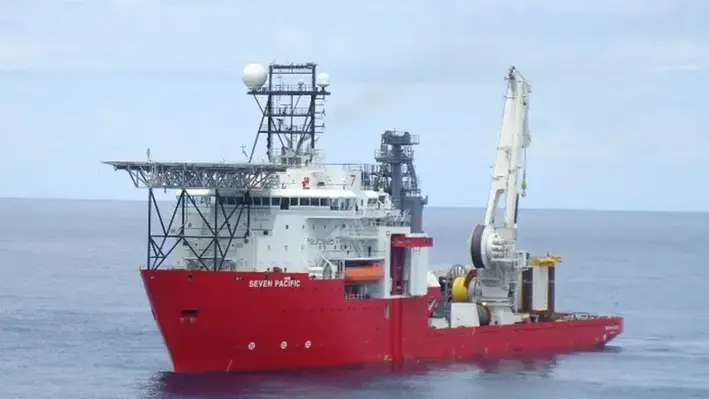 Subsea7 has confirmed the award of a significant project under its long-term agreement (LTA) with Aramco, targeting offshore infrastructure in Saudi Arabia.
Subsea7 has confirmed the award of a significant project under its long-term agreement (LTA) with Aramco, targeting offshore infrastructure in Saudi Arabia.
The scope of the contract covers engineering, procurement, construction, and installation (EPCI) of 106 kilometres of infield and export pipelines. It also includes modifications to existing topside structures and associated hook-up activities.
Project engineering and management will commence immediately from Subsea7’s offices in Saudi Arabia and the UAE, with offshore execution planned across 2027 and 2028.
David Bertin, Senior Vice President for Subsea7’s Global Projects Centre East, said, “This project marks another important milestone and reinforces our long-term strategic engagement with Aramco. We look forward to working closely with the client to deliver this project safely, efficiently, and to the highest standards.”
This award highlights Subsea7’s continued presence in the Middle East and its strategic alignment with Aramco’s offshore development initiatives. The project strengthens regional operations and demonstrates Subsea7’s capability to deliver complex offshore energy solutions in partnership with key clients.
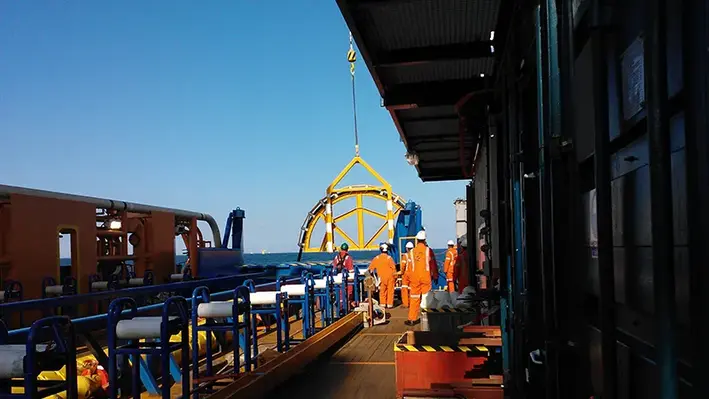
 Tekmar Group, based in the UK, has secured another significant contract in the Middle East, continuing its strong momentum in the region
Tekmar Group, based in the UK, has secured another significant contract in the Middle East, continuing its strong momentum in the region
This new deal, valued at over $10 million, involves the provision of Tekmar's advanced cable protection system, TekDuct, and engineered ballast modules for an offshore energy project in the United Arab Emirates.
The contract is with a leading international engineering, procurement, and construction (EPC) contractor. Under the agreement, Tekmar will design and manufacture its polyurethane cable protection system, with work beginning immediately and final delivery scheduled for the first quarter of 2026.
Richard Turner, CEO of Tekmar Group, said, “We are delighted to partner again with this major customer on a significant energy project. This award reflects our strong presence and track record in the Middle East and underpins our position as a market leader in supporting customers with high-quality engineered asset protection technology."
He added, “This contract is also an important marker as we translate our healthy pipeline to good quality orders and build the platform for sustained growth for 2026 and beyond.”
Earlier this year, Tekmar also announced a contract for the supply of bespoke subsea infrastructure technology for a pipeline project in the Middle East, though the exact location has not been disclosed. In August, the company secured two offshore grouting contracts in Qatar, valued at approximately $1.6 million, to support subsea infrastructure inspection, maintenance, and repair (IMR) campaigns.
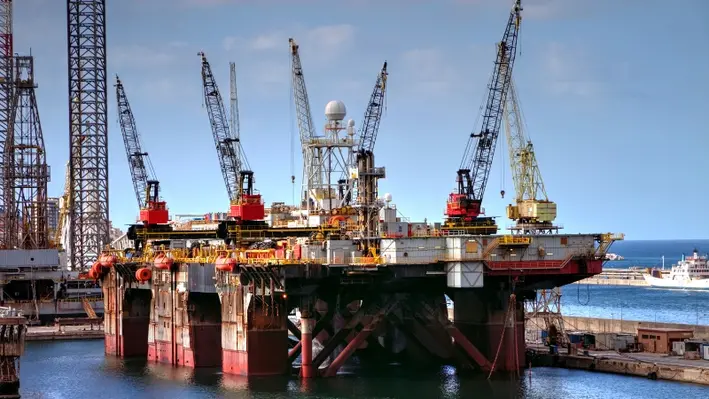

HIMA Group, the global safety automation expert, is setting new benchmarks for functional safety in the offshore industry. The company is showcasing its expanded portfolio, which combines decades of expertise with next-generation digitalisation to enhance safety, security, and efficiency across oil and gas, offshore wind, hydrogen, and carbon storage operations.
With Sella Controls and Origo Solutions now part of the HIMA Group, operators and contractors benefit from powerful synergies and a broadened offering that covers the entire safety automation value chain. Together, the group is delivering unmatched consulting, engineering, and project execution expertise across conventional and renewable offshore projects.
At the heart of HIMA’s portfolio is its independent open safety platform, which integrates hardware and software on a single technology base. Certified by TÜV, Lloyd’s Register, Bureau Veritas and DNV, the platform enables functional safety, OT security, and compliance with international standards, while also driving process efficiency and improving plant availability.
Under its #safetygoesdigital strategy, HIMA is accelerating the transition toward digitalised safety lifecycle management. This includes innovative tools like Safety Lifecycle Digitalisation (SLD) Cockpits, which use dashboards and data-driven monitoring to optimise productivity, streamline compliance, and improve safety outcomes.
HIMA Group's solutions are employed all over the world, but especially in the Middle East through the HIMA Middle East division located in Dubai.
The group’s proven solutions extend from high-integrity pressure protection systems (HIPPS) with Planar 4 technology for critical offshore applications, to turbomachinery control solutions with SIL3 compliance and advanced load-sharing capabilities. Origo Solutions’ SCADA+ platform brings flexible control and visualisation across wind, hydrogen, and oil and gas plants, now further enriched by HIMA integration. Meanwhile, FLOWorX® delivers comprehensive pipeline management and leak detection with high sensitivity and real-time monitoring, also suitable for hydrogen applications.
Other highlights include SafeHMI, a new approach to safe plant operations with inherent safety features and digitalised management of change. These developments reflect HIMA’s vision of building a future where digitalisation strengthens safety and resilience across the offshore sector.
By uniting the expertise of HIMA, Sella Controls, and Origo Solutions, the group is shaping the future of functional safety in offshore operations and reinforcing its position as a trusted partner for energy companies navigating both traditional and renewable transitions.
Page 1 of 11
Copyright © 2025 Offshore Network